The date is 17 January 2017 and it’s a chilly Tuesday morning in London. The British cabinet and assorted media have assembled at Lancaster House, an old 18th century mansion in the West End, and expectation is in the air.
UK prime minister Theresa May is about to deliver a speech which will outline her vision for the UK’s future relationship with the European Union. The prime minister would finally make clear what “Brexit means Brexit” actually meant.
In her Lancaster House speech, Mrs May laid down her roadmap for Brexit, stating it was her intention to take the UK out of the European single market and the EU-wide customs union. May said it was also her intention to invoke Article 50 of the treaty of the European Union by the end of March 2017, thereby setting in motion a two-year countdown for the UK to negotiate its exit from the EU.
As Mrs May finished her speech in London, Dublin Port CEO Eamonn O’Reilly looked out his office window across Dublin Bay and knew things were about to change. It was time to get to work at Ireland’s largest port.
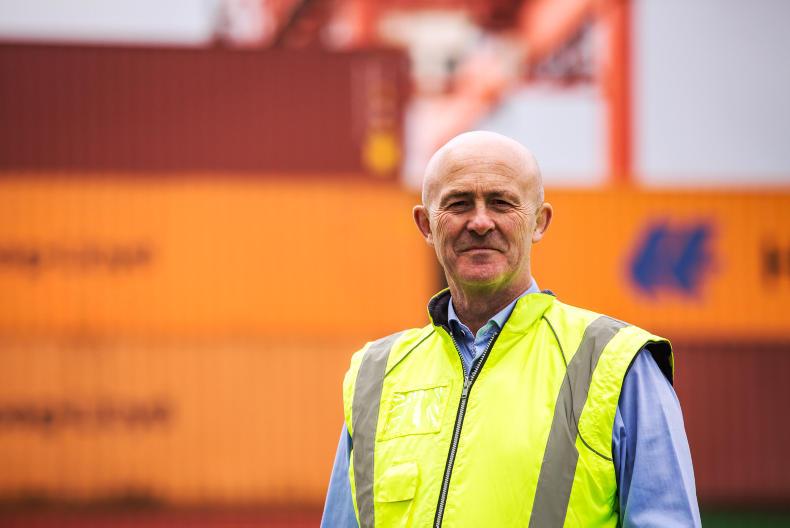
Eamon O'Reilly, CEO of the Dublin Port Co, at the docks in East Wall, Co Dublin. \ Philip Doyle
“After the Lancaster House speech, we decided to take the UK at its word that it was leaving the customs union and the single market of the EU, which would mean we were going to need physical infrastructure to check goods and people entering Ireland from the UK,” says O’Reilly.
“We needed to work on the basis that they were leaving both the customs union and the single market. We just couldn’t wait around for political agreement and a deal to be reached,” he adds.
Theresa May held to her word and triggered Article 50 at the end of March 2017. The countdown was on and Dublin Port had exactly two years to build the necessary infrastructure to deal with the regulatory changes Brexit would bring.
Enormous
For those who have never been, Dublin Port is enormous. Set on 260ha (643 acres) near the East Wall part of the city, some 38m tonnes of cargo moved in and out of Dublin Port in 2018, which is the fourth consecutive year of record cargo volumes through the port.
As O’Reilly points out, Dublin Port isn’t the largest port in Europe, but it’s certainly one of the busiest. Just over 1.8m passengers land at the port via ferries and cruise ships every year, many of whom are coming from the UK. The port is also a critical entry point for animal feed imports such as soya and maize.
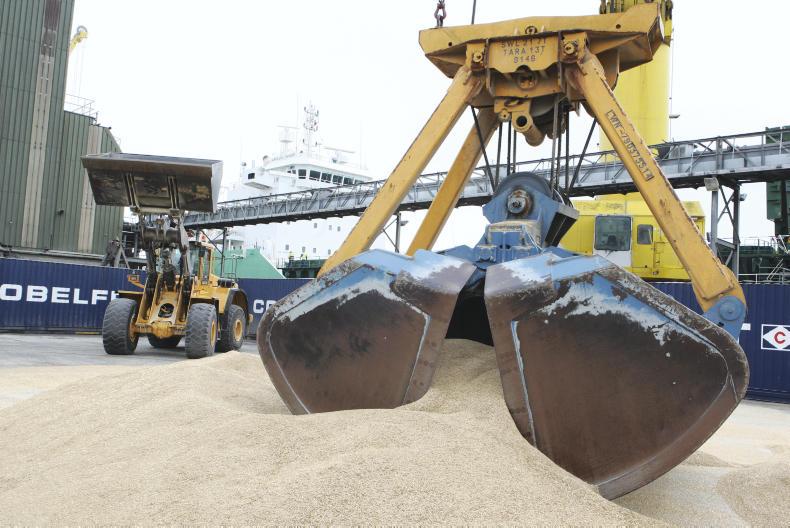
Grain being imported through Dublin Port.
A number of the major Irish grain traders, including R&H Hall, Cefetra and Arkady Feeds, have facilities at the port. In 2018, some 2.4m tonnes of bulk solid commodities such as animal feed and cereals were imported via Dublin, which was up almost 20% on the previous year due to the fodder crisis in the late winter/early spring, as well as the summer drought conditions that followed.

Adjacent to the R&H Hall grain terminal at the port stands an old Odlums flour mill (pictured) – a relic of a time gone by when flour milling was a significant industry in this country. Today, the mill stands silent having long been decommissioned. The facility has recently been acquired by Dublin Port Company and will likely be demolished in the years ahead.
Just as Ireland’s economy has evolved over the last 30 years, so too has Dublin Port adapted to meet the needs of the country’s importers and exporters. However, 2019 will see one of the biggest changes made at Dublin Port in decades as it seeks to adapt to a new trading regime between Ireland and our largest trade partner, the UK.
Infrastructure
By 1 April 2019, when the Irish Farmers Journal paid a visit to Dublin Port, the work on the new border infrastructure was virtually complete. A small team of men were pouring paint to mark out new laneways and road markings to direct traffic through the new customs post but everything else was in place. The infrastructure had to be ready for 28 March, the day before the UK had originally planned to leave the UK, says O’Reilly.
“After Brexit, if you’re coming on a ferry out of Holyhead or Liverpool with Irish Ferries or Stena Line, whether you’re a passenger or a haulier, you will have to transit through this new border inspection area,” says O’Reilly. “This will be the first point of contact passengers or hauliers will have with the Irish State.”
In the two years since the Lancaster House speech, Dublin Port has spent €30m building these new border and customs controls as well as acquiring some assets on the port for future plans. A 3ha yard has also been given over to the Department of Agriculture where sanitary and phytosanitary (SPS) checks will be carried by officials from the Department of Agriculture on all food and animal byproducts after Brexit.
Some of the cargo going in for SPS checks will also be subject to a physical examination and will have to go to another warehouse on the port where the container will be opened and product may be taken out and tested.
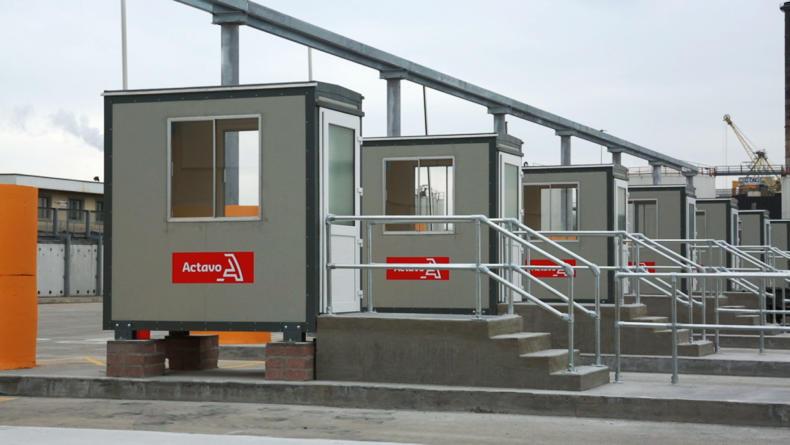
The newly built primary inspection post at Dublin Port.
To manage the volume of checks required after Brexit, the Irish Government has sought to hire 800 new staff across various roles in the different arms of the State, including Revenue, Customs and the Department of Agriculture. In total, almost 3% of the land at Dublin Port has been given over to the Irish Government for inspection space for Revenue, Customs, the Department of Agriculture and the Department of Health post-Brexit.
Imports
The scale of the task facing the Irish State in checking every unit of cargo imported from the UK is daunting. In 2018, a total of 1.4m cargo units (roll-on/roll-off trucks and load-on/load-off containers) were imported through Dublin Port.
Of this, more than 60%, or 850,000 units, came from the UK. Every day, 16 ferries land at Dublin Port from the UK – eight from Liverpool-Heysham and another eight from Holyhead. Every single one of the 850,000 cargo units coming off these ships will need to be checked and often physically inspected after Brexit.
Due to the nature of just-in-time supply chains, much of the 850,000 cargo units coming into Dublin Port from the UK contain food, which is destined for distribution centres and supermarket shelves around Ireland.
Food products or any goods of animal origin will have to undergo SPS checks by officials from the Department of Agriculture, meaning food supply chains are particularly exposed after Brexit.
“We enjoyed a remarkable period from 1992 [creation of the single market] where products coming from the UK simply flowed off the ferries and out the gate of Dublin Port to the M50. All of that changes once Brexit happens,” laments the Dublin Port chief.
We just won’t know if this infrastructure is enough until the new trading regime starts. The only thing we know is that goods will move more slowly through Dublin Port than they have up to now
Away from the soap opera in the House of Commons, with all the in-fighting and posturing, this is the great sadness of Brexit. After hundreds of years of war and bad blood between our two countries, the EU’s single market brought Ireland and the UK closer than ever before.
Our countries met as equals around the table of the European Council in Brussels and trade flourished between both islands.
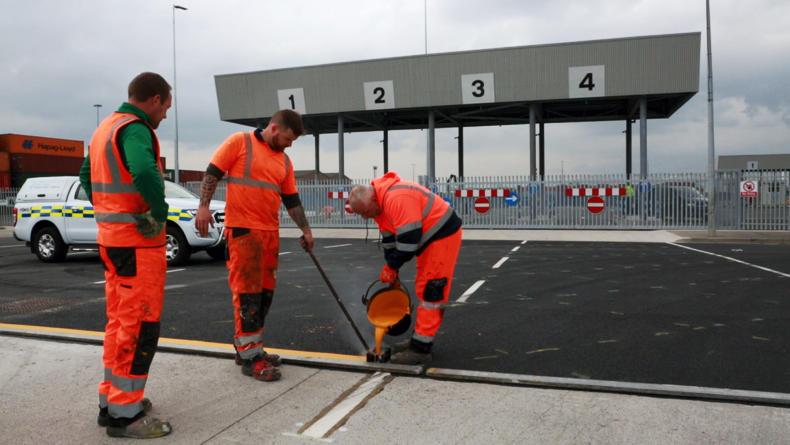
Workers putting the finishing touches to the newly built primary inspection post at Dublin Port.
Most important of all, the EU single market was critical to developing a precious peace on the island of Ireland after the 1998 Good Friday Agreement. It allowed goods and people to move freely north and south and a true all-island economy prospered.
Borders
Instead of building on this close relationship, Ireland now finds itself building border controls at its ports ahead of the UK’s exit from the EU. Brexit has brought nothing but uncertainty for Irish businesses trying to plan ahead.
However, what is absolutely certain from Brexit is that trade between our two islands is going to move a lot slower in the future and at a higher cost.
Worryingly, O’Reilly says he can’t even be sure if the €30m invested to date in these brand new border inspection posts will be enough capacity to handle the volume of cargo that will have to be checked.
We enjoyed a remarkable period from 1992 where products coming from the UK simply flowed off the ferries and out the gate of Dublin Port to the M50
“We just won’t know if it’s enough until the new trading regime starts,” says O’Reilly. “The only thing we know is that goods will move more slowly through Dublin Port than they have up to now.”
Since the Brexit vote in 2016, the most obvious impact on businesses in the agri-food sector of the UK’s decision to leave the EU has been the weakness in sterling. However, currency markets go up and down all the time.
Once the UK finally agrees a deal and begins its transition period to leave the EU, the changes coming at places like Dublin Port are where Ireland’s agri-food sector will start to feel a new and more permanent impact from Brexit.
Ultimately, Brexit will cost time and money for Irish food exporters, which will only have a negative effect on the sector’s competitiveness.
The date is 17 January 2017 and it’s a chilly Tuesday morning in London. The British cabinet and assorted media have assembled at Lancaster House, an old 18th century mansion in the West End, and expectation is in the air.
UK prime minister Theresa May is about to deliver a speech which will outline her vision for the UK’s future relationship with the European Union. The prime minister would finally make clear what “Brexit means Brexit” actually meant.
In her Lancaster House speech, Mrs May laid down her roadmap for Brexit, stating it was her intention to take the UK out of the European single market and the EU-wide customs union. May said it was also her intention to invoke Article 50 of the treaty of the European Union by the end of March 2017, thereby setting in motion a two-year countdown for the UK to negotiate its exit from the EU.
As Mrs May finished her speech in London, Dublin Port CEO Eamonn O’Reilly looked out his office window across Dublin Bay and knew things were about to change. It was time to get to work at Ireland’s largest port.

Eamon O'Reilly, CEO of the Dublin Port Co, at the docks in East Wall, Co Dublin. \ Philip Doyle
“After the Lancaster House speech, we decided to take the UK at its word that it was leaving the customs union and the single market of the EU, which would mean we were going to need physical infrastructure to check goods and people entering Ireland from the UK,” says O’Reilly.
“We needed to work on the basis that they were leaving both the customs union and the single market. We just couldn’t wait around for political agreement and a deal to be reached,” he adds.
Theresa May held to her word and triggered Article 50 at the end of March 2017. The countdown was on and Dublin Port had exactly two years to build the necessary infrastructure to deal with the regulatory changes Brexit would bring.
Enormous
For those who have never been, Dublin Port is enormous. Set on 260ha (643 acres) near the East Wall part of the city, some 38m tonnes of cargo moved in and out of Dublin Port in 2018, which is the fourth consecutive year of record cargo volumes through the port.
As O’Reilly points out, Dublin Port isn’t the largest port in Europe, but it’s certainly one of the busiest. Just over 1.8m passengers land at the port via ferries and cruise ships every year, many of whom are coming from the UK. The port is also a critical entry point for animal feed imports such as soya and maize.

Grain being imported through Dublin Port.
A number of the major Irish grain traders, including R&H Hall, Cefetra and Arkady Feeds, have facilities at the port. In 2018, some 2.4m tonnes of bulk solid commodities such as animal feed and cereals were imported via Dublin, which was up almost 20% on the previous year due to the fodder crisis in the late winter/early spring, as well as the summer drought conditions that followed.

Adjacent to the R&H Hall grain terminal at the port stands an old Odlums flour mill (pictured) – a relic of a time gone by when flour milling was a significant industry in this country. Today, the mill stands silent having long been decommissioned. The facility has recently been acquired by Dublin Port Company and will likely be demolished in the years ahead.
Just as Ireland’s economy has evolved over the last 30 years, so too has Dublin Port adapted to meet the needs of the country’s importers and exporters. However, 2019 will see one of the biggest changes made at Dublin Port in decades as it seeks to adapt to a new trading regime between Ireland and our largest trade partner, the UK.
Infrastructure
By 1 April 2019, when the Irish Farmers Journal paid a visit to Dublin Port, the work on the new border infrastructure was virtually complete. A small team of men were pouring paint to mark out new laneways and road markings to direct traffic through the new customs post but everything else was in place. The infrastructure had to be ready for 28 March, the day before the UK had originally planned to leave the UK, says O’Reilly.
“After Brexit, if you’re coming on a ferry out of Holyhead or Liverpool with Irish Ferries or Stena Line, whether you’re a passenger or a haulier, you will have to transit through this new border inspection area,” says O’Reilly. “This will be the first point of contact passengers or hauliers will have with the Irish State.”
In the two years since the Lancaster House speech, Dublin Port has spent €30m building these new border and customs controls as well as acquiring some assets on the port for future plans. A 3ha yard has also been given over to the Department of Agriculture where sanitary and phytosanitary (SPS) checks will be carried by officials from the Department of Agriculture on all food and animal byproducts after Brexit.
Some of the cargo going in for SPS checks will also be subject to a physical examination and will have to go to another warehouse on the port where the container will be opened and product may be taken out and tested.

The newly built primary inspection post at Dublin Port.
To manage the volume of checks required after Brexit, the Irish Government has sought to hire 800 new staff across various roles in the different arms of the State, including Revenue, Customs and the Department of Agriculture. In total, almost 3% of the land at Dublin Port has been given over to the Irish Government for inspection space for Revenue, Customs, the Department of Agriculture and the Department of Health post-Brexit.
Imports
The scale of the task facing the Irish State in checking every unit of cargo imported from the UK is daunting. In 2018, a total of 1.4m cargo units (roll-on/roll-off trucks and load-on/load-off containers) were imported through Dublin Port.
Of this, more than 60%, or 850,000 units, came from the UK. Every day, 16 ferries land at Dublin Port from the UK – eight from Liverpool-Heysham and another eight from Holyhead. Every single one of the 850,000 cargo units coming off these ships will need to be checked and often physically inspected after Brexit.
Due to the nature of just-in-time supply chains, much of the 850,000 cargo units coming into Dublin Port from the UK contain food, which is destined for distribution centres and supermarket shelves around Ireland.
Food products or any goods of animal origin will have to undergo SPS checks by officials from the Department of Agriculture, meaning food supply chains are particularly exposed after Brexit.
“We enjoyed a remarkable period from 1992 [creation of the single market] where products coming from the UK simply flowed off the ferries and out the gate of Dublin Port to the M50. All of that changes once Brexit happens,” laments the Dublin Port chief.
We just won’t know if this infrastructure is enough until the new trading regime starts. The only thing we know is that goods will move more slowly through Dublin Port than they have up to now
Away from the soap opera in the House of Commons, with all the in-fighting and posturing, this is the great sadness of Brexit. After hundreds of years of war and bad blood between our two countries, the EU’s single market brought Ireland and the UK closer than ever before.
Our countries met as equals around the table of the European Council in Brussels and trade flourished between both islands.

Workers putting the finishing touches to the newly built primary inspection post at Dublin Port.
Most important of all, the EU single market was critical to developing a precious peace on the island of Ireland after the 1998 Good Friday Agreement. It allowed goods and people to move freely north and south and a true all-island economy prospered.
Borders
Instead of building on this close relationship, Ireland now finds itself building border controls at its ports ahead of the UK’s exit from the EU. Brexit has brought nothing but uncertainty for Irish businesses trying to plan ahead.
However, what is absolutely certain from Brexit is that trade between our two islands is going to move a lot slower in the future and at a higher cost.
Worryingly, O’Reilly says he can’t even be sure if the €30m invested to date in these brand new border inspection posts will be enough capacity to handle the volume of cargo that will have to be checked.
We enjoyed a remarkable period from 1992 where products coming from the UK simply flowed off the ferries and out the gate of Dublin Port to the M50
“We just won’t know if it’s enough until the new trading regime starts,” says O’Reilly. “The only thing we know is that goods will move more slowly through Dublin Port than they have up to now.”
Since the Brexit vote in 2016, the most obvious impact on businesses in the agri-food sector of the UK’s decision to leave the EU has been the weakness in sterling. However, currency markets go up and down all the time.
Once the UK finally agrees a deal and begins its transition period to leave the EU, the changes coming at places like Dublin Port are where Ireland’s agri-food sector will start to feel a new and more permanent impact from Brexit.
Ultimately, Brexit will cost time and money for Irish food exporters, which will only have a negative effect on the sector’s competitiveness.






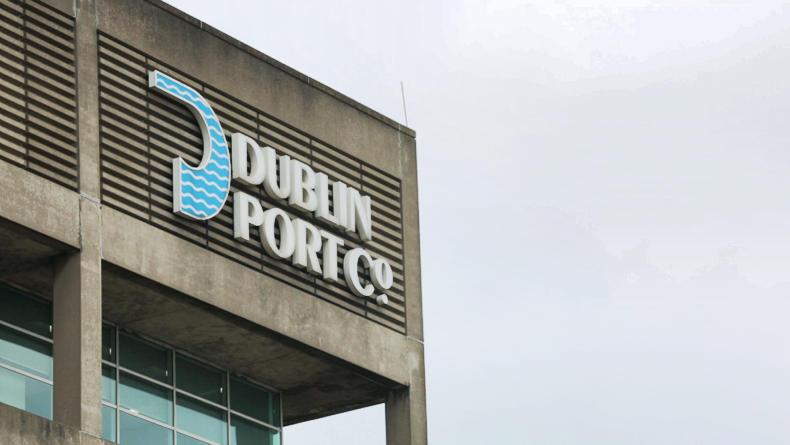




 This is a subscriber-only article
This is a subscriber-only article















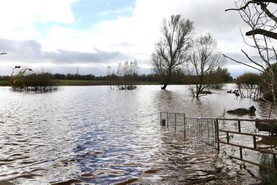

SHARING OPTIONS: